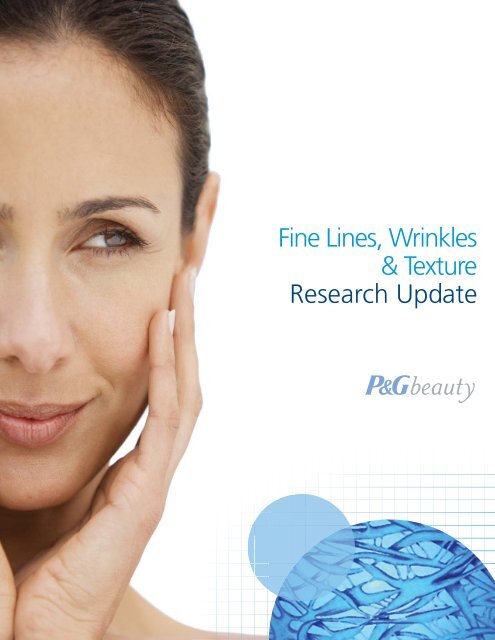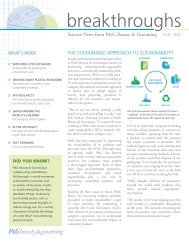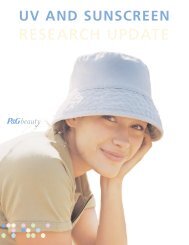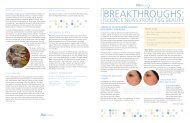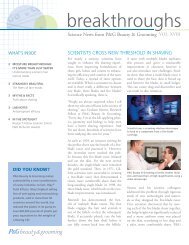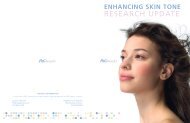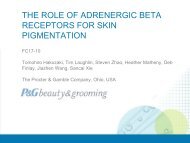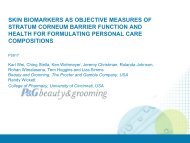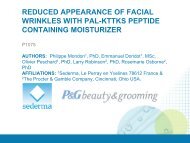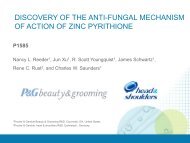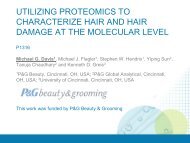Fine Lines, Wrinkles & Texture Research Update - P&G Beauty ...
Fine Lines, Wrinkles & Texture Research Update - P&G Beauty ...
Fine Lines, Wrinkles & Texture Research Update - P&G Beauty ...
You also want an ePaper? Increase the reach of your titles
YUMPU automatically turns print PDFs into web optimized ePapers that Google loves.
<strong>Fine</strong> <strong>Lines</strong>, <strong>Wrinkles</strong><br />
& <strong>Texture</strong><br />
<strong>Research</strong> <strong>Update</strong>
contents<br />
The State of Anti-Aging<br />
Skin Care<br />
1 Skin care science advances as<br />
market proliferation and consumer<br />
confusion increases<br />
<strong>Fine</strong> <strong>Lines</strong>, <strong>Wrinkles</strong><br />
& <strong>Texture</strong> Infl uence<br />
Self-Perception<br />
2 How fi ne lines, wrinkles and<br />
texture contribute to perceptions<br />
of age<br />
Biology of <strong>Fine</strong> <strong>Lines</strong>,<br />
<strong>Wrinkles</strong> & <strong>Texture</strong><br />
3 Defi ning the Problem<br />
Where a fi ne line ends and a<br />
wrinkle begins<br />
4 Targeting the Problem Where<br />
it Occurs<br />
The common facial areas where<br />
problems appear<br />
4 Intrinsic & Extrinsic Factors<br />
Associated with Skin Aging<br />
The skin’s responses to biological<br />
aging and environmental exposures<br />
6 The Fundamentals of<br />
Preventing and Reversing<br />
the Signs of Skin Aging<br />
Talking points on how to minimize<br />
wrinkles and strengthen skin<br />
Innovations in<br />
Technology &<br />
Clinical Testing<br />
6 Advances in Molecular Testing<br />
From genomics to metabolomics<br />
and beyond<br />
7 Advances in Preclinical and<br />
Clinical Testing<br />
A new age of safety and effi cacy<br />
testing<br />
Addressing <strong>Fine</strong> <strong>Lines</strong>,<br />
<strong>Wrinkles</strong> & <strong>Texture</strong><br />
Changes<br />
10 Topical Anti-Aging Compounds<br />
A table of some of the most<br />
researched and popular skin care<br />
compounds<br />
11 What Works<br />
The latest research on antioxidants<br />
and UV protection, retinoids, niacinamide<br />
and peptides<br />
Infl ammatory Responses<br />
& Their Relationship<br />
to Skin<br />
16 Putting the Pieces Together:<br />
Genomics, Infl ammation and<br />
Skin Aging<br />
Infl ammatory pathways and their<br />
effects on skin aging
The State of Anti-Aging Skin Care<br />
The appearance of fi ne lines and wrinkles is one of the most<br />
common signs of aging in people around the world. Yet, regardless<br />
of when wrinkles are fi rst noticed, they are an unwelcome<br />
indicator of age, especially for women who are leading more<br />
active lives and are looking for ways to look and feel their best.<br />
Increased life expectancy has changed the concept of aging and,<br />
in turn, propelled anti-aging research that has led to a multitude of<br />
topical applications. Skin science is advancing at an exponential<br />
pace, yet profound gaps remain in patients’ understanding of the<br />
biological mechanisms of skin and the research supporting interventions<br />
that can help to preserve supple, smooth, youthful skin<br />
and nourish, replenish and renew aging skin.<br />
Amid the proliferation of specialty<br />
anti-aging products and the<br />
ensuing consumer confusion, the<br />
anti-aging fi eld is booming with<br />
discoveries made possible through<br />
the application of complex science<br />
and advanced technologies including<br />
the gene chip, sophisticated<br />
medical imaging tools and computational<br />
models. With a focus on<br />
the physical and molecular basis<br />
of fi ne lines, wrinkles and poor<br />
texture, P&G <strong>Beauty</strong> scientists have<br />
brought exacting precision to this<br />
area of dermatological study and<br />
have translated their knowledge to<br />
drive the identifi cation of improved<br />
anti-aging ingredients.<br />
As scientists continue to search for<br />
breakthroughs, deeper analyses of<br />
bio logical pathways that distinguish<br />
young and aging skin are providing<br />
new insights into the processes of<br />
skin aging which will in turn lead to<br />
better preventive measures and antiaging<br />
treatments.<br />
<strong>Fine</strong> <strong>Lines</strong>, <strong>Wrinkles</strong> & <strong>Texture</strong>: <strong>Research</strong> <strong>Update</strong> 1
<strong>Fine</strong> <strong>Lines</strong>, <strong>Wrinkles</strong><br />
& <strong>Texture</strong> Infl uence<br />
Self-Perception<br />
Th roughout the evolution of skin<br />
care, fi ne lines, wrinkles and texture<br />
have been persistent concerns for<br />
aging women. <strong>Research</strong> reveals that<br />
this concern is legitimate and related<br />
to self-image and age-related discrimination.<br />
Poor self-image is associated<br />
with chronic illness and fewer<br />
preventive health behaviors, such as<br />
exercise, 1 and aged skin, particularly<br />
in women, has also been linked to<br />
job discrimination. 1 Such far-reaching<br />
psycho-social implications help<br />
explain the ongoing quest to develop<br />
better treatments to conceal and<br />
delay the signs of aging.<br />
As this quest has progressed, skin care<br />
formulators have sought to use the<br />
best science available to address fi ne<br />
lines, wrinkles and texture problems.<br />
As illustrated in the timeline below, a<br />
snapshot of trends over past decades<br />
Decades of Skin Care<br />
1960s<br />
Moisturization is<br />
key to wrinkle reduction<br />
(e.g., propylene<br />
glycol, lactate)<br />
2 <strong>Fine</strong> <strong>Lines</strong>, <strong>Wrinkles</strong> & <strong>Texture</strong>: <strong>Research</strong> <strong>Update</strong><br />
1970s<br />
Super-moisturization<br />
ingredients debut<br />
(e.g., glycerol,<br />
petrolatum)<br />
demonstrates that the approaches to<br />
addressing the problem have evolved<br />
in step with technological advances<br />
and a wider availability of ingredients.<br />
In tandem with the increased availability<br />
of specialty creams and lotions,<br />
consumers have become more aware<br />
of and concerned with the multitude<br />
of factors relating to aging skin.<br />
<strong>Research</strong>ers have found there are<br />
seven key signs of aging that concern<br />
women and these concerns are consistently<br />
identifi ed, regardless of their<br />
diverse lifestyles and ethnicities.<br />
P&G <strong>Beauty</strong> conducted surveys with<br />
over 6,000 women across three continents<br />
and found the following concerns<br />
to be consistently identifi ed:<br />
• <strong>Fine</strong> lines and wrinkles<br />
• Skin texture<br />
• Skin tone<br />
• Skin surface dullness<br />
• Visible pores<br />
• Blotchiness and age spots<br />
• Dryness<br />
1980s<br />
Exfoliation is the rage<br />
(e.g., hydroxy acids)<br />
While this longer list of concerns<br />
suggests that women are increasingly<br />
taking a more holistic view of the<br />
signs of skin’s aging, fi ne lines and<br />
wrinkles continue to be a prime concern<br />
for women. As one of the fi rst<br />
visible manifestations of aging in a<br />
world that values youthful appearances,<br />
there are no indications that<br />
the focus on fi ne lines and wrinkles<br />
will wane. But how much do wrinkles<br />
and fi ne lines contribute to selfperceptions<br />
compared to these other<br />
age-related factors?<br />
To better understand the relative contribution<br />
of fi ne lines and wrinkles<br />
versus skin color unevenness on selfperceptions,<br />
P&G <strong>Beauty</strong> researchers<br />
conducted a study to isolate the<br />
role that fi ne lines and wrinkles play.<br />
In the study, researchers took digital<br />
facial images of subjects 40 years or<br />
older using a custom high-resolution<br />
digital imaging system. Th ese images<br />
were then subjected to the digital<br />
removal of fi ne lines, wrinkles and<br />
color unevenness. Finally, groups of<br />
1990s<br />
Age-defying ingredients<br />
make news<br />
(e.g., retinoids)<br />
2000s<br />
An ever-expanding<br />
range of specialty<br />
ingredients leads to<br />
better products, but<br />
also consumer confusion<br />
(e.g., niacinamide,<br />
peptides)
panelists were asked to identify the<br />
age of the images they were shown.<br />
Preliminary fi ndings reveal that fi ne<br />
lines and wrinkles are the primary<br />
factors impacting perceptions of<br />
female facial age. Th ese early fi ndings<br />
underscore the need for further<br />
research to elucidate the connection<br />
between skin aging and perceptions,<br />
and reinforce eff orts to discover better<br />
and more accessible anti-aging<br />
solutions.<br />
Biology of <strong>Fine</strong><br />
<strong>Lines</strong>, <strong>Wrinkles</strong><br />
& <strong>Texture</strong><br />
In looking at the biological mechanisms<br />
which lead to fi ne lines,<br />
wrinkles and changing texture, it is<br />
important to start with clear working<br />
defi nitions of these phenomena. Th is<br />
is especially important because they<br />
often overlap, the progression from<br />
one to the other is subtle and the<br />
measurements used to evaluate them<br />
vary across the fi eld of dermatology.<br />
Adding to this complexity, one must<br />
take into account that these phenomena<br />
are driven by both intrinsic and<br />
extrinsic factors and that these factors<br />
are highly interrelated. As science<br />
unravels each nuance of these processes,<br />
better strategies for addressing<br />
the undesirable eff ects of skin aging<br />
are emerging, and P&G <strong>Beauty</strong> sci-<br />
entists and their collaborators are<br />
constantly seeking new insights that<br />
will ultimately lead to improved antiaging<br />
treatments.<br />
Defi ning the Problem<br />
Across dermatological literature,<br />
there are various synonyms and characteristics<br />
used to describe fi ne lines,<br />
wrinkles and inconsistent texture,<br />
and consequently, defi nitions have<br />
been somewhat broad and expansive.<br />
In their work, P&G <strong>Beauty</strong> researchers<br />
utilize the criteria below to defi ne<br />
fi ne lines, wrinkles and inconsistent<br />
texture:<br />
Surface <strong>Wrinkles</strong>/<strong>Fine</strong> <strong>Lines</strong><br />
• Crevices in the surface of the skin<br />
that only delve into the epidermal<br />
layer<br />
• Less than 0.1mm in depth<br />
Wrinkle<br />
Fold<br />
Line<br />
• May either disappear upon relaxation<br />
or be barely discernible<br />
• Th ought to be reducible/eliminated<br />
without the use of invasive<br />
procedures<br />
Deep <strong>Wrinkles</strong>/Folds<br />
• Crevices in the skin surface that<br />
delve into the dermal layer (deep<br />
wrinkles) and even into the subcutaneous<br />
layer (folds)<br />
• Greater than 0.1mm in depth, up<br />
to 0.4mm in depth<br />
• Remain well-defi ned and evident<br />
upon the relaxation of the muscles<br />
and the skin<br />
Inconsistent <strong>Texture</strong><br />
• Enlarged pore size<br />
• “Bumpy” texture<br />
• Rough or fl aky texture<br />
Epidermis<br />
Dermis<br />
Subcutis<br />
<strong>Fine</strong> <strong>Lines</strong>, <strong>Wrinkles</strong> & <strong>Texture</strong>: <strong>Research</strong> <strong>Update</strong> 3
Targeting the Problem<br />
Where It Occurs<br />
Experts agree that wrinkles usually<br />
begin as fi ne lines. Generally, these<br />
lines are found in the areas used most<br />
frequently in facial expressions and<br />
those highly exposed to UV rays.<br />
As a result, wrinkles are commonly<br />
found in the areas pictured below.<br />
Additionally, inconsistent skin texture<br />
can be found on many areas<br />
of the face, most noticeably on the<br />
nose and cheek area (“bumpy” texture,<br />
enlarged pores) and the area<br />
between the eye and the ear. Other<br />
texture problems that can be found<br />
across the entire face are rough or<br />
fl aky texture and scarring or pitting<br />
from acne.<br />
Forehead<br />
Crows feet<br />
Enlarged<br />
pores<br />
Upper & lower lip<br />
Chin/underside of chin<br />
4 <strong>Fine</strong> <strong>Lines</strong>, <strong>Wrinkles</strong> & <strong>Texture</strong>: <strong>Research</strong> <strong>Update</strong><br />
Intrinsic & Extrinsic Factors<br />
Associated with Skin Aging<br />
A large body of research has helped to<br />
delineate intrinsic and extrinsic factors<br />
at work in aging skin. Th e process of<br />
intrinsic skin aging follows a similar<br />
trajectory as that of most internal<br />
organs, with factors including inevitable<br />
changes in hormone levels, particularly<br />
estrogen, as well as declines<br />
in metabolic activity and cell regeneration.<br />
2 Extrinsic skin aging is caused<br />
primarily by UV exposure; 3 however,<br />
exposure to environmental pollution<br />
and smoking are also signifi cant factors.<br />
Yet, while science has, for research<br />
purposes, categorized age-inducing<br />
factors as either intrinsic or extrinsic,<br />
increasing evidence demonstrates their<br />
interdependencies; specifi cally, we are<br />
Bumpy texture<br />
Laughter lines<br />
Corners of mouth<br />
In addition to the problem areas shown above, rough or fl aky texture can appear anywhere<br />
on the face.<br />
Skin Facts<br />
• Up to approximately mid-30s, the<br />
skin epidermis renews itself every<br />
4-6 weeks. As the body ages, the<br />
renewal time slows to about 6-8<br />
weeks.<br />
• The skin of an average woman<br />
weighs about 3 kg, and that of an<br />
average man approximately 5 kg.<br />
• The thickness of the skin varies,<br />
depending on its site on the body. It<br />
is thinnest on the eyelids and thickest<br />
on the palms of the hands and<br />
the soles of the feet.<br />
learning more about the ways extrinsic<br />
factors accelerate intrinsic aging.<br />
One example of the complex interplay<br />
of factors involves free radicals,<br />
which are both generated internally<br />
through normal metabolic processes<br />
and produced as a consequence of<br />
external factors, including UV exposure.<br />
As a result of the age-associated<br />
decline in protective internal antioxidant<br />
mechanisms, free radicals<br />
accumulate in the body and alter<br />
both the proteins and the DNA<br />
in the skin. In fact, according to a<br />
recent study published in Nature, 4<br />
the buildup of damaged DNA drives<br />
the aging process. In addition, ongoing<br />
accumulation of internally-generated<br />
free radicals combined with<br />
those generated from UV and other
external assaults (surfactants, allergens,<br />
and other irritants) can promote<br />
a chronic infl ammatory state.<br />
Th is chronic infl ammatory state<br />
compromises skin health and accelerates<br />
the aging process; for example,<br />
proteolytic enzymes are produced,<br />
resulting in collagen degradation. 5<br />
Other changes resulting from the<br />
complex interplay between intrinsic<br />
and extrinsic factors that impact the<br />
appearance of fi ne lines, wrinkles and<br />
texture include the following:<br />
• Th ickness of the epidermis, cellular<br />
turnover rate of both the epider mis<br />
and the stratum corneum declines<br />
and epidermal diff erentiation is<br />
6, 7 altered.<br />
• Dermis becomes thinner as major<br />
structural molecules including collagen,<br />
elastin and glycosaminoglycans<br />
decrease in amount. 8, 9, 10 Metalloproteinase<br />
activity also decreases<br />
in photodamaged skin and the<br />
structure of these molecules<br />
becomes disorganized and cross-<br />
11, 12, 13, 14, 15<br />
linked.<br />
• Convolution of dermal-epidermal<br />
junction (Rete ridges) fl attens with<br />
age, resulting in a loss of mechanical<br />
strength. 16 Th is also leads to<br />
decreased microcirculation to the<br />
upper dermis and, thus, decreased<br />
nourishment to the epidermis.<br />
• Age-related changes in inter- and<br />
intra-cellular signaling lead to<br />
17, 18<br />
decreases in collagen synthesis.<br />
• Changes in hyaluronic acid content<br />
within the skin varies with<br />
age. Hyaluronic acid is a natural<br />
moisturizer within the skin binding<br />
up to 1000 times its weight in<br />
water. Age-related declines result<br />
in compromised moisturization<br />
19, 20<br />
and fi rmness.<br />
• Decrease in intracellular energy<br />
sources including ATP and NADH<br />
lead to an inability of skin cells to<br />
sustain youthful skin biochemistry,<br />
thereby reducing the skin’s ability<br />
to maintain and restore youthful<br />
skin structure. 21<br />
Th ese changes work together to compromise<br />
skin’s elasticity, fi rmness and<br />
structure, which contributes to areas<br />
of collapse and irregularity and ultimately<br />
manifests as fi ne lines, wrinkles<br />
and texture problems.<br />
As P&G <strong>Beauty</strong> scientists continue<br />
to study how these processes contribute<br />
to fi ne lines, wrinkles and<br />
texture changes, they’re also seeking<br />
to better understand what processes<br />
impact other consumer-relevant signs<br />
of aging, including skin tone, surface<br />
dullness, pore size, blotchiness, age<br />
spots and dryness. Th e intention of this<br />
ongoing research is to develop antiaging<br />
products that can comprehensively<br />
approach the many factors that<br />
lead to the appearance of aging skin.<br />
Innovations in<br />
Technology &<br />
Clinical Testing<br />
With our advancing understanding<br />
of the biology of fi ne lines and<br />
wrinkles comes the application of<br />
more sophisticated technologies and<br />
more rigorous research methods to<br />
measure the eff ects of topical treatments.<br />
Gone are the days of trial<br />
and error, when the effi cacy of topical<br />
interventions was determined by<br />
treating symptoms without a clear<br />
sense of the underlying biological<br />
mechanisms. Now, researchers are<br />
utilizing a host of complex sciences<br />
and technologies to understand these<br />
<strong>Fine</strong> <strong>Lines</strong>, <strong>Wrinkles</strong> & <strong>Texture</strong>: <strong>Research</strong> <strong>Update</strong> 5
mechanisms, and designing their<br />
studies to eliminate the uncertainties<br />
and subjectivity that colored earlier<br />
conclusions.<br />
Advances in Molecular Testing<br />
At the molecular level, P&G <strong>Beauty</strong><br />
researchers are bringing to bear several<br />
complex sciences to gain a more<br />
complete picture of skin aging. Th ese<br />
sciences include:<br />
• Genomics: a branch of biotechnology<br />
which applies genetic and<br />
molecular biology techniques to<br />
the genetic mapping and DNA<br />
sequencing of sets of genes or<br />
the complete genomes of selected<br />
organisms.<br />
• <strong>Wrinkles</strong> and poor texture are among the earliest signs of aging.<br />
Over time, the skin becomes thinner, drier and less elastic. The<br />
timing and severity of the appearance of fi ne lines and wrinkles<br />
is due to:<br />
– Your genetic predisposition to wrinkles and the natural aging<br />
process<br />
– Exposure to sunlight and other environmental irritants, including<br />
pollution<br />
• Overexposure to the sun is the main culprit of premature agerelated<br />
changes, including wrinkles, roughness, altered pigmentation,<br />
loss of skin tone and dilated blood vessels. To protect<br />
your skin, use a daily moisturizer with broad spectrum SPF 15<br />
sunscreen included. If you plan to be outside, apply and reapply<br />
sunscreen and don’t forget to wear a hat, protective clothing<br />
and sunglasses. Try to limit your exposure to the sun during the<br />
middle of the day when UV light is at its strongest.<br />
6 <strong>Fine</strong> <strong>Lines</strong>, <strong>Wrinkles</strong> & <strong>Texture</strong>: <strong>Research</strong> <strong>Update</strong><br />
• Proteomics: a branch of biotechnology<br />
which applies the techniques<br />
of molecular biology,<br />
bio chemistry and genetics to analyzing<br />
the structure, function and<br />
interactions of the proteins produced<br />
by the genes of a particular<br />
cell, tissue or organism.<br />
• Metabolomics: the systematic study<br />
of the unique chemical fi nger prints<br />
that specifi c cellular processes leave<br />
behind; specifi cally, the study of<br />
their small-molecule metabolite<br />
profi le.<br />
• Bioinformatics: the use of techniques<br />
including applied mathematics,<br />
infor ma tics, statistics,<br />
The Fundamentals of Preventing & Reversing the Signs of Aging Skin<br />
com puter science, artifi cial intelligence,<br />
chemistry and biochemistry<br />
to solve biological problems, usually<br />
on the molecular level.<br />
Of these applied disciplines, one<br />
of the most exciting areas of P&G<br />
<strong>Beauty</strong> research is genomics, where<br />
the sequencing of the human genome<br />
has given scientists an exponentially<br />
larger toolbox from which to learn<br />
and innovate targeted interventions.<br />
Owing directly to the breakthroughs<br />
of modern genetics, researchers now<br />
have the ability to identify the specifi<br />
c human genes that are modulated<br />
in response to various stimuli.<br />
• Supplement the protective effects of broad spectrum<br />
SPF 15 coverage with anti-aging treatments that can help<br />
strengthen the skin, including the skin barrier, and reverse<br />
the signs of aging. These include topical antioxidants, niacinamide,<br />
N-acetyl glucosamine (NAG) and peptides, among others.<br />
• Quit smoking or don’t start. Cigarette smoke causes marked<br />
decreases in the antioxidant capacity of skin and production of<br />
new collagen.<br />
• Exercise regularly to help fl ush impurities out of your skin. Exercising<br />
also facilitates the production of sebum, which is the skin’s<br />
natural moisturizer, and improves blood fl ow to the skin.<br />
• Optimize your immune function and skin’s natural self-repair<br />
mechanisms by drinking plenty of water, eating a well-balanced<br />
diet and getting plenty of rest.
Gene Chip Technology<br />
One new technology that has been<br />
developed as an outgrowth of the<br />
sequencing of the human genome is<br />
a gene-monitoring device known as<br />
the gene chip. Th e gene chip’s versatile<br />
technology has led to it being<br />
used by researchers studying various<br />
diseases including autism, bipolar<br />
disease, cancer, diabetes and heart<br />
disease. In addition to these applications,<br />
the gene chip technology is<br />
enabling P&G <strong>Beauty</strong> researchers to<br />
understand the underlying biological<br />
basis of changes seen on the skin surface,<br />
including changes in fi ne lines<br />
and wrinkles.<br />
Th e chip itself has indicators that represent<br />
genes comprising the human<br />
genome. By placing fragments of<br />
Tiled onto an Affymetrix gene chip are oligonucleatide<br />
probes representing over 35,000 genes.This<br />
technology has revolutionized genomics research<br />
and is being used extensively by P&G <strong>Beauty</strong><br />
scientists.<br />
fl uorescently-tagged samples isolated<br />
from the skin onto the chip, scientists<br />
can see which genes are expressed<br />
within the sample and whether these<br />
genes are up-regulated or down-regulated,<br />
indicating specifi c molecular<br />
events contributing to a given biological<br />
process.<br />
Advances in Preclinical<br />
& Clinical Testing<br />
Along the long road from molecular<br />
to preclinical and fi nally clinical testing<br />
at P&G <strong>Beauty</strong>, ingredients and<br />
their subsequent product applications<br />
must pass clear safety and effi -<br />
cacy benchmarks before even being<br />
considered for market introduction.<br />
Beginning with testing on in vitro<br />
skin equivalents and advancing to in<br />
vivo effi cacy testing, these measurements<br />
have elevated the legitimacy of<br />
skin care science and the rigor upon<br />
which skin care claims are made.<br />
In vitro Human Skin Equivalents<br />
Th e imperative for skin product<br />
safety, combined with ethical, social<br />
and political pressures, has fostered<br />
improvements in alternatives for animal<br />
testing. One of the leading technologies<br />
that has been developed is<br />
human skin equivalent culture models.<br />
In recent years, advancements in<br />
techniques have led to cultures that<br />
mimic not only the epidermal layer<br />
but also the dermal layer, allowing<br />
these models to be used not only for<br />
safety assessments22 but also to test<br />
23, 24, 25<br />
product effi cacy.<br />
In vitro human skin equivalents reproduce many<br />
cellular and structural elements of natural skin,<br />
including the dermis, epidermis and melanocytes.<br />
Human skin equivalent cultures receive nutrients<br />
from the bottom of the culture. This facilitates<br />
application of topical ingredients, both water<br />
soluble and non-water soluble, on the top of the<br />
culture.<br />
Today’s human skin equivalents off er<br />
multiple advantages over traditional<br />
monolayer cultures:<br />
• Can be used to test undiluted<br />
materials (e.g., product formulations)<br />
which is important because<br />
not all materials are water-soluble<br />
• Are able to show cell-to-cell<br />
interaction between dermis and<br />
epidermis<br />
• Clinically relevant measures can<br />
be performed (e.g., barrier eff ects<br />
with TEWL, hydration)<br />
<strong>Fine</strong> <strong>Lines</strong>, <strong>Wrinkles</strong> & <strong>Texture</strong>: <strong>Research</strong> <strong>Update</strong> 7
Clinical Test Design<br />
In today’s era of sophisticated skin science,<br />
clinicians and consumers alike<br />
are calling for data on cosmetic products<br />
that are based on the same level of<br />
scientifi c rigor that is required of drug<br />
trials. While such trials are voluntary<br />
and require signifi cant investments in<br />
time and resources, P&G <strong>Beauty</strong> has<br />
long adhered to testing methodologies<br />
for cosmetic products that exceed<br />
those required by governmental regulatory<br />
bodies and that are relied upon<br />
by most beauty companies.<br />
Consistent with this commitment,<br />
P&G <strong>Beauty</strong> regularly conducts randomized,<br />
double-blinded clinical trials.<br />
26, 27, 28, 29, 30 Using these protocols,<br />
participants are randomly assigned<br />
to one of two or more treatment<br />
regimens, and neither the study participants<br />
nor the researchers know<br />
which participants are receiving the<br />
test therapy and which are receiving<br />
a placebo or control therapy.<br />
Th ese measures, though exhaustive,<br />
ensure potential selection biases are<br />
eliminated and that fi ndings are both<br />
objective and reproducible.<br />
Ghosting Method: Increases<br />
Accuracy of Before & After<br />
Comparisons<br />
Th e technical diffi culties involved<br />
with capturing visual data and the<br />
absence of clear digital image capture<br />
standards have resulted in many<br />
dubious before and after comparisons<br />
8 <strong>Fine</strong> <strong>Lines</strong>, <strong>Wrinkles</strong> & <strong>Texture</strong>: <strong>Research</strong> <strong>Update</strong><br />
throughout dermatological literature.<br />
Facial expression, head position and<br />
lighting are all critical factors in determining<br />
whether a wrinkle has become<br />
smaller, larger or remained the same<br />
size and depth. Th e challenge is compounded<br />
because the more subtle the<br />
change, the more critical changes in<br />
these factors become.<br />
Given these challenges, it has taken<br />
advances in technology and scrupulous<br />
scientists to bring rigor to the<br />
process of eff ective digital imaging<br />
of aging skin. One advance that has<br />
helped solidify digital imaging as a<br />
serious documentation and measurement<br />
tool is “ghosting” technology.<br />
By replicating the original lighting<br />
and facial positioning to the most<br />
precise degree, the ghosting method<br />
helps ensure the most accurate possible<br />
assessments of skin changes,<br />
whether those changes are being<br />
determined objectively by computer<br />
image analysis or subjectively by<br />
graders or consumers.<br />
How It Works: During the subject’s<br />
initial visit, the operator captures<br />
the baseline image. At follow-up, the<br />
operator recalls the subject’s baseline<br />
image, or repositioning image,<br />
in a semi-transparent “ghost image”<br />
format.<br />
When the camera system is activated,<br />
it brings up both the baseline ghost<br />
image and an overlaid live subject<br />
Ghost image from baseline visit.<br />
Aligning the ghost and current live image.<br />
image. Th e operator aligns the baseline<br />
ghost image and overlaid live<br />
image, matching the subject’s live<br />
head position and facial expression<br />
with the baseline ghost image.<br />
Th e goal of this technological process<br />
is to minimize possible confounding<br />
variables. Not only does this help<br />
advance science by providing more<br />
precise measures, it bolsters the validity<br />
of claims and is in the best interest<br />
of consumers.
Visit 1 Visit 2<br />
Perfectly repositioned subject, even months later.<br />
FOITS Topography Maps<br />
In the world of skin science, the value<br />
of obtaining skin surface topography<br />
in vivo cannot be understated,<br />
but the data obtained is only as valuable<br />
as it is precise. In their ongoing<br />
quest for more precise measurement<br />
instruments, P&G <strong>Beauty</strong> researchers<br />
acquired a new measurement technology<br />
known as FOITS (Fast Optical<br />
In Vivo Topometry of Human Skin)<br />
to augment their existing topographical<br />
measurement system.<br />
How It Works: FOITS uses the principle<br />
of “fringe projection” to analyze<br />
the topographic features (height variations)<br />
of the skin surface. An appro-<br />
priate analogy for “fringe protection”<br />
in image capture can be made by<br />
imagining light passing through<br />
window blinds and onto an object.<br />
While stripes of light are cast onto<br />
the object, they distort the geometry<br />
of the object. But the original geometry<br />
of the object can be captured by<br />
comparing the coordinates where the<br />
light stripes meet the parallel shadow<br />
stripes. FOITS applies this same<br />
principle to skin’s topographical features.<br />
A parallel stripe pattern is fi rst<br />
projected onto the skin surface. Th e<br />
instrument then calculates the x-y-z<br />
coordinates where the original stripe<br />
pattern and the parallel dark pattern<br />
meet, generating precise data on the<br />
true skin topography.<br />
Upon acquiring FOITS, P&G <strong>Beauty</strong><br />
researchers used the technology to<br />
assess the performance of existing<br />
product lines. Th eir fi ndings were<br />
extremely satisfying — the technology<br />
itself yielded better measurements and<br />
the tested products met or exceeded<br />
study endpoints. Th is is especially<br />
Example of FOITS before and after comparison images showing the benefi ts of a test topical antiaging<br />
cream. The outer boxes contain images of wrinkles in the crow’s feet area following treatment<br />
with a test topical anti-aging cream. The inner boxes represent topographical heat maps of<br />
this same area and clearly indicate reduced fi ne lines and wrinkles.<br />
rewarding, given that the FOITS system<br />
is increasingly gaining recognition<br />
for its ability to validate product<br />
claims and that the technology has<br />
been adopted as the standard for antiaging<br />
product claims in Germany.<br />
Addressing <strong>Fine</strong><br />
<strong>Lines</strong>, <strong>Wrinkles</strong> &<br />
<strong>Texture</strong> Changes<br />
In addition to the expanded range of<br />
topical anti-aging technologies available,<br />
the variety of cosmetic procedures<br />
(e.g., face lifts, fi llers and facial<br />
peels) has multiplied in recent years.<br />
While these more invasive and costly<br />
procedures are the right decision for<br />
some, many patients prefer topical<br />
interventions, are averse to invasive<br />
procedures or fi nd them cost prohibitive.<br />
For these reasons, it is important<br />
to stay up-to-date on the latest<br />
skin care ingredients that are backed<br />
by science and can address patients’<br />
anti-aging concerns. 31<br />
Scientifi c research has substantiated<br />
the mechanism of action of several<br />
wrinkle-fi ghting ingredients. While<br />
the variety of compounds found in<br />
today’s skin care products continues<br />
to grow, not all are backed by signifi -<br />
cant clinical research. Th e table on the<br />
following page describes some of<br />
the more popular and well-researched<br />
31, 32<br />
anti-aging ingredients.<br />
<strong>Fine</strong> <strong>Lines</strong>, <strong>Wrinkles</strong> & <strong>Texture</strong>: <strong>Research</strong> <strong>Update</strong> 9
TOPICAL ANTI-AGING COMPOUNDS<br />
Ingredient/Compound Mechanism of Action<br />
Ascorbic Acid — a potent organic acid with<br />
antioxidant properties, commonly known<br />
as vitamin C. Forms of this vitamin include<br />
ascorbic acid, ascorbyl phosphate, ascorbyl<br />
palmitate and ascorbyl glucoside.<br />
CoQ10 — a naturally occurring compound<br />
found in every cell in the body that acts as<br />
an antioxidant. Also known as ubiquinone.<br />
N-acetyl Glucosamine (NAG) — a simple<br />
amino sugar and nutrient that plays a role in<br />
forming and maintaining the body’s tissues.<br />
Niacinamide — a water soluble B3 vitamin<br />
found naturally in the body. Forms of vitamin<br />
B3 that are typically used in skin care products<br />
include niacinamide (also called “nicotinamide”),<br />
nicotinic acid and nicotinate esters.<br />
Panthenol — present in all living cells and<br />
a major component of co-enzyme A, which<br />
serves a critical role in cellular metabolism.<br />
Peptides — natural or synthetic compounds<br />
containing two or more linked amino acids.<br />
Peptides that are of particular interest to the cosmetic<br />
industry include palmitoyl-lysine-threoninethreonine-lysine-serine<br />
(pal-KTTKS; Matrixyl ® )<br />
and palmitoyl-lysine threonine (pal-KT).<br />
Retinoids — derivatives of vitamin A. Retinoic<br />
acid is the functional form of vitamin A in<br />
skin and is considered to be the gold-standard<br />
Rx anti-aging treatment. Other forms of<br />
vitamin A used cosmetically include retinol,<br />
retinyl-propionate and retinaldehyde.<br />
Salicylic Acid — derivative of beta-hydroxy<br />
acid. Other forms of hydroxy acids used cosmetically<br />
include glycolic, malic, tartaric, lactic<br />
and critic acids; and polyhydroxy acids such<br />
as gluconolactone and lactobionic acid.<br />
Other Antioxidants — include alphalipoic<br />
acid, tocopherol and lutein and<br />
are employed in the cosmetic arena.<br />
Tocopherol is an isomer of vitamin E.<br />
Sunscreens — Include avobenzone,<br />
octocrylene, titanium dioxide or zinc oxide.<br />
10 <strong>Fine</strong> <strong>Lines</strong>, <strong>Wrinkles</strong> & <strong>Texture</strong>: <strong>Research</strong> <strong>Update</strong><br />
Based on in vitro experiments, vitamin C has been shown to promote collagen synthesis.<br />
Cosmetic studies demonstrate several skin anti-aging effects from the use of<br />
topical vitamin C. 3% ascorbic acid has been shown to reduce oxidative damage by<br />
neutralizing free radicals as well as to reduce facial wrinkles. 5–17% ascorbic acid<br />
minimizes facial photoaging, improves skin texture and increases skin elastin.<br />
Neutralizes harmful free radicals and protects skin from damaging effects. Higher levels<br />
of CoQ10 result in increased production of collagen and elastin. Penetrates epidermal<br />
layers to reduce level of oxidation and diminish depth of fi ne lines/wrinkles.<br />
Experiments treating cells in culture with N-acetyl-glucosamine have demonstrated signifi<br />
cant increases in both hyaluronic acid and collagen. In human clinical testing, topically<br />
applied NAG improves skin moisturization as well as the appearance of fi ne lines/wrinkles.<br />
In vitro experiments establish that niacinamide increases collagen production,<br />
decreases sebum production and increases barrier-containing lipids and proteins.<br />
Clinical studies have demonstrated a range of benefi ts including a reduction<br />
in the appearance of fi ne lines and wrinkles, minimized skin pore size and<br />
decreased appearance of hyper-pigmented spots, blotchiness and skin sallowness.<br />
In vitro studies of cells treated with panthenol demonstrate increased synthesis of stratum<br />
corneum lipids. Topically-applied panthenol in human clinical testing has shown increased<br />
hydration of the stratum corneum and improved roughness and elasticity of skin.<br />
In vitro studies prove that synthetic pal-KTTKS stimulates collagen production and<br />
reduces excess dermal GAGs. In addition, in vitro pal-KT enhances the reduction of<br />
collagen alone and synergistically with pal-KTTKS. Clinical studies show topical pal-<br />
KTTKS and pal-KT products improve the appearance of wrinkles and texture.<br />
In vitro studies demonstrate retinoid-induced changes in the expression of genes<br />
relevant to dermal matrix production, epidermal differentiation and melanin production.<br />
Specifi cally, retinoids stimulate the production of collagen and decrease<br />
the production of dermal GAGs. Retinoids have also been shown to increase the<br />
production of epidermal hyaluronic acid. Clinical studies demonstrate that topical<br />
doses of retinoids less than 1% are signifi cantly effective in reducing hyperpigmentation,<br />
roughness and the appearance of facial fi ne lines/wrinkles.<br />
Salicylic Acid proves to exfoliate the stratum corneum resulting in improved skin<br />
texture and color appearance. Clinical studies of topical salicylic acid have demonstrated<br />
improvements in the appearance of wrinkling, roughness and discoloration.<br />
In in vitro experiments, antioxidants neutralize free radicals, protect skin<br />
cells from oxidation and thwart other antioxidants from oxidizing. In particular,<br />
tocopherol has the potential to improve skin problems caused by UV exposure<br />
such as sunburn, skin photoaging and hyperpigmentation. Used topically,<br />
these antioxidants have been shown to diminish the appearance of aging.<br />
Chemical sunscreens absorb UV radiation while physical sunscreens block UV rays.<br />
A physical or “broad spectrum” sunscreen is an effi cient tool to protect against<br />
both UVA and UVB rays, which contribute to wrinkles, freckles and age spots.<br />
Prevents<br />
Repairs<br />
Prevents<br />
& Repairs
What Works<br />
In recent years, science has uncovered<br />
a great deal about how to prevent<br />
extrinsic skin aging as well as<br />
the anti-aging benefi ts of retinoids,<br />
niacinamide and peptides.<br />
Prevention of Extrinsic Skin Aging<br />
Everyone has heard the old adage<br />
that an ounce of prevention equals<br />
a pound of cure, but in the arena of<br />
skin science, it is only recently that<br />
we’ve gained a clearer understanding<br />
of what should be prevented and how.<br />
Th anks to research advancements,<br />
we now know both the consequences<br />
of extrinsic factors and what can be<br />
done to avoid, or at least limit, their<br />
deleterious eff ects.<br />
In the area of UV protection,<br />
increased understanding of the role<br />
of UVA rays in both cancer and skin<br />
aging has led to stronger emphasis on<br />
“broad spectrum” coverage that protects<br />
against UVA and UVB rays, as<br />
well as the introduction of improved<br />
UVA fi lters. Th is progress is continuing<br />
to be built upon through<br />
enhanced technologies that deliver<br />
the protection consumers need along<br />
with the product aesthetics we know<br />
improve sunscreen compliance. 33<br />
Progress has also been made in better<br />
understanding the role of antioxidants<br />
in inhibiting reactive oxygen<br />
species (ROS) formation and thereby<br />
interrupting free radical chain propa-<br />
gation, a major pathway for UV- and<br />
other environmentally-induced skin<br />
damage. In a recent study, P&G<br />
<strong>Beauty</strong> researchers 34 used fl uorescence<br />
microscopy to visualize and<br />
quantify the protective eff ect of topically-applied<br />
antioxidants for inhibiting<br />
ROS formation across several<br />
sources of oxidative stressors, including<br />
UV light, automotive emissions<br />
and ozone. Th e effi cacy of sunscreen<br />
alone and in combination with antioxidants<br />
was also evaluated.<br />
Key fi ndings include:<br />
• Topically applied antioxidant<br />
formulations were eff ective at<br />
signifi cantly inhibiting free radical<br />
formation, with reductions of<br />
19–88% versus antioxidant-free<br />
vehicle controls observed against<br />
three oxidative stressors.<br />
• An antioxidant/SPF 15 formulation<br />
gave signifi cantly reduced ROS<br />
(91% reduction) versus either<br />
antioxidant-only (88% reduction)<br />
or SPF-only (61% reduction) controls<br />
(p
Retinoids include:<br />
• Retinol<br />
• Retinaldehyde<br />
• Retinyl Esters (retinyl propionate,<br />
retinyl palmitate)<br />
• Tretinoin (trans-retinoic acid)<br />
• Adapalene<br />
• Tazarotene<br />
moderate skin irritation that may<br />
persist over the course of topical<br />
use, 36 and the associated teratogenic<br />
eff ects. In recent years, new synthetic<br />
derivatives of vitamin A that have<br />
been developed for use on human<br />
skin minimize cutaneous irritation<br />
and other unwanted eff ects. Clinical<br />
trials comparing retinol to retinyl<br />
esters suggest that retinyl propionate,<br />
the propionic acid ester of retinol,<br />
delivers skin benefi ts that are similar<br />
to using retinol (e.g., improvement<br />
in appearance of wrinkles and<br />
pigment spots) but with less irritation.<br />
37 Because of the skin’s enhanced<br />
sensitivity to sunlight when using<br />
retinoids, adequate sun protection<br />
must be factored into treatment. A<br />
12-week study evaluated the use of<br />
retinol and retinyl propionate both<br />
co-applied with sunscreen. Th ose<br />
using retinyl propionate and sunscreen<br />
showed a signifi cant reduction<br />
in the appearance of wrinkles and<br />
sunspots with no irritation. Con-<br />
12 <strong>Fine</strong> <strong>Lines</strong>, <strong>Wrinkles</strong> & <strong>Texture</strong>: <strong>Research</strong> <strong>Update</strong><br />
Baseline After 12 Weeks<br />
Effect of retinyl propionate upon photodamaged skin. 0.2% retinyl propionate in a<br />
stable skin care emulsion system was applied twice daily for 12 weeks. Images were<br />
taken at baseline and week 12.<br />
versely, the retinol-sunscreen combination<br />
appeared to exacerbate skin<br />
irritation and lessened the skin benefi<br />
ts. 37 Retinyl propionate appears to<br />
off er dermatologists a milder, more<br />
tolerable form of retinoid that can<br />
improve the look of photoaged skin,<br />
while guarding against additional sun<br />
damage and irritation.<br />
Niacinamide<br />
Topical niacinamide, a water-soluble<br />
derivative of vitamin B3, provides<br />
a host of dermatological therapeutic<br />
benefi ts. Clinical research provides<br />
grow ing evidence for its positive<br />
eff ects on skin health, from help-<br />
ing maintain barrier integrity<br />
29, 30,<br />
38, 39, 40 to diminishing the signs<br />
of aging, including: (1) reducing fi ne<br />
lines and wrinkles, 29 (2) reducing<br />
texture problems by diminishing<br />
the appearance of pores 41, 42 and (3)<br />
improving skin tone by reducing the<br />
appearance of hyperpigmentation,<br />
skin yellowing and red blotchiness. 29<br />
Niacinamide is also well-tolerated<br />
and compatible with other anti-aging<br />
technologies, making it an ideal<br />
choice for skin care. 29 In fact, it has<br />
recently been shown that the use of<br />
niacinamide-containing moisturizer<br />
during topical tretinoin therapy mitigates<br />
the severity of side eff ects and<br />
augments the treatment response. 43<br />
Th e eff ects of niacinamide on skin<br />
cells in culture have been explored<br />
extensively. Niacinamide has been<br />
shown to be a key player in the normalization<br />
of age-associated depletions<br />
of nicotinamide coenzymes.<br />
Th is is of particular importance for<br />
aged skin since systemic and intracellular<br />
concentrations of the nicotinamide<br />
coenzymes NADH and<br />
NADPH decline with age in human<br />
and animal models. 44, 45, 46 Th ese<br />
cofactors are critical drivers of both<br />
catabolic and anabolic processes<br />
within cells including the production<br />
and maintenance of the dermis. In
Effect Of Niacinamide On Increase In Collagen Synthesis In Human Dermal Fibroblasts<br />
particular, niacinamide supplementation<br />
has been shown to stimulate<br />
collagen synthesis in human dermal<br />
fi broblasts, 47 an eff ect that would be<br />
of particular signifi cance in aged and<br />
photodamaged skin.<br />
Multiple clinical studies have demonstrated<br />
the positive eff ects of niacinamide-containing<br />
moisturizers on the<br />
appearance of wrinkles and fi ne lines<br />
in aging skin. 29, 48 In one, 29 a 12-week<br />
randomized, split-face trial, 50 female<br />
subjects applied blind-coded product<br />
Total protein Total collagen<br />
Collagen: total<br />
protein ratio<br />
500uM niacinamide 41% 54% 35%<br />
These data demonstrate that niacinamide treatment has a positive effect on collagen production relative to<br />
control and that there is specifi city for collagen biosynthesis and secretion relative to other cellular proteins.<br />
BETTER<br />
Change in fine lines/wrinkles area vs. baseline<br />
5.00 –<br />
0.00 –<br />
-5.00 –<br />
-10.00 –<br />
-15.00 –<br />
-20.00<br />
followed by image analysis. Signifi cant<br />
improvements were seen in several<br />
facial parameters including appearance<br />
of fi ne lines and wrinkles (p=0.06 at<br />
week 8 and 0.0005 at week 12).<br />
In another study, 40 female subjects<br />
applied blind-coded products in a<br />
split-face design for 12 weeks. Significant<br />
improvements in skin texture<br />
including fi ne line appearance were<br />
observed in niacinamide-treated skin<br />
at both four and 12 weeks of treatment<br />
(p
Peptides<br />
Th e use of peptides in commercial<br />
products has signifi cantly risen in<br />
recent years. Known to play a role in<br />
wound-healing, naturally occurring<br />
peptides in the skin have been shown in<br />
vitro to: (1) stimulate the production<br />
of extracellular matrix components<br />
including collagen, elastin and fi bronectin<br />
and (2) decrease the production<br />
of dermal GAGs. 49, 50 Decreased<br />
dermal matrix components and<br />
increased dermal GAGs are hallmark<br />
features of aged skin, 51 the reversal of<br />
which has been hypothesized as a viable<br />
approach to anti-aging.<br />
With variations in amino acid<br />
sequence, number of amino acids<br />
and use of derivatives of these acids,<br />
there are limitless combinations of<br />
possible peptides. By testing the eff ect<br />
of multiple peptides on the synthesis<br />
of collagen in culture, scientists<br />
at the University of Tennessee<br />
49, 50<br />
narrowed the fi eld of possible amino<br />
acid combinations to a pentapeptide<br />
fragment of pro-collagen, KTTKS<br />
(lysine-threonine-threonine-lysineserine).<br />
Th is peptide retained 80%<br />
of the collagen-stimulating activity<br />
of the original, much larger 34–44<br />
amino acid pro-collagen peptide<br />
from which it was derived.<br />
Because transdermal delivery of ionic<br />
peptides is likely to pose a signifi cant<br />
issue for delivery of bioactive peptide<br />
into the skin, a palmitoyl derivative<br />
14 <strong>Fine</strong> <strong>Lines</strong>, <strong>Wrinkles</strong> & <strong>Texture</strong>: <strong>Research</strong> <strong>Update</strong><br />
Collagen synthesis (% of control)<br />
250 –<br />
200 –<br />
150 –<br />
100 –<br />
50 –<br />
0<br />
Control 4ppm pal-KTTKS<br />
In cell culture experiments, pal-KTTKS increases<br />
collagen synthesis.<br />
–<br />
–<br />
of KTTKS (pal-KTTKS) was used,<br />
which capitalizes on research conducted<br />
on peptides to improve transcutaneous<br />
delivery. 52<br />
Consistent with the collagenstimulating<br />
eff ects of the underivatized<br />
KTTKS, pal-KTTKS promotes<br />
the production of collagen in organotypic<br />
cultures of human skin cells. 24<br />
In addition, pal-KTTKS eff ectively<br />
reduces dermal GAGs at 1/10 th the<br />
dose of trans-retinoic acid (tRA). 53<br />
Th e promotion of these eff ects in<br />
vitro are consistent with the antiaging<br />
strategy proposed above.<br />
Multiple clinical studies have demonstrated<br />
the signifi cant eff ect of formu<br />
lations containing pal-KTTKS on<br />
wrinkle reduction and facial appearance<br />
improvement. In one study, 54<br />
60 subjects were treated for four<br />
months in a split-faced doubleblinded<br />
trial. Th e pal-KTTKS<br />
test product produced signifi cant<br />
% reduction in GAGs<br />
% change over 4 months<br />
70 –<br />
60 –<br />
50 –<br />
40 –<br />
30 –<br />
20 –<br />
10 –<br />
0<br />
5 –<br />
0 –<br />
-5 –<br />
-10 –<br />
-15 –<br />
-20 –<br />
-25 –<br />
-30 –<br />
-35 –<br />
-40<br />
0.9ppm<br />
pal-KTTKS<br />
% change vs. To p< 0.01 % change vs. To p< 0.015<br />
Wrinkle volume<br />
(μm 3 )<br />
–<br />
5 –<br />
0 –<br />
-5 –<br />
-10 –<br />
-15 –<br />
-20 –<br />
-25 –<br />
-30<br />
¢ pal-KTTKS<br />
¢ tRA control<br />
10ppm tRA<br />
(*10ppm = 0.001%)<br />
In in vitro cell culture experiments, pal-KTTKS<br />
reduces GAGs comparably at 1/10 th the dose of<br />
tRA (10 ppm = 0.001%).<br />
¢ pal-KTTKS<br />
¢ Vehicle<br />
Wrinkle depth<br />
(μm)<br />
Moisturizer containing pal-KTTKS decreases both<br />
wrinkle volume and depth following 4 months of<br />
treatment.<br />
–<br />
improve ments versus the vehicle in<br />
wrinkle volume and wrinkle depth<br />
at two- and four-month time points.<br />
Results were based on quantitative<br />
image analysis of skin replicas.<br />
In another split-face double-blinded<br />
study of 92 subjects, 27 signifi cant
improvements were seen in wrinkle<br />
appearance (week 12 p=
16 <strong>Fine</strong> <strong>Lines</strong>, <strong>Wrinkles</strong> and <strong>Texture</strong>: <strong>Research</strong> <strong>Update</strong><br />
Infl ammatory<br />
Responses &<br />
Their Relationship<br />
to Skin<br />
Infl ammatory responses, which occur<br />
in the vascularized connective tissue,<br />
are intended to be protective, destroying<br />
the organism of both the initial<br />
cause of cell injury (e.g., microbes,<br />
toxins) and the consequences of<br />
such injury (e.g., necrotic cells and<br />
tissues). Without infl ammation,<br />
infections would go unchecked and<br />
wounds would not heal; however, the<br />
process of infl ammation and repair<br />
can also be harmful. Infl ammatory<br />
mechanisms play a key role in the<br />
pathogenesis of chronic conditions<br />
including cardiovascular disease,<br />
colorectal cancer, stroke, type 2 diabetes,<br />
COPD and Alzheimer’s disease.<br />
It is also increasingly recognized<br />
as a potent independent predictor<br />
of all-cause mortality. Th e risk of<br />
chronic infl ammation correlates with<br />
increasing age and certain lifestyle<br />
factors, including smoking, obesity<br />
and poor dietary patterns.<br />
Th e term “infl ammaging” was coined<br />
by Claudio Franceschi 58 to describe<br />
the cascade of autoimmune infl ammatory<br />
responses that lead to chronic<br />
low-level infl ammation. Infl ammaging<br />
is a useful clinical construct<br />
because we know that all the major<br />
diseases associated with aging share<br />
an infl ammatory pathogenesis. Th e<br />
defi ning characteristic of infl ammaging<br />
is an up-regulation of multiple<br />
anti-stress responses at the cellular<br />
and molecular level. Th is rampant<br />
up-regulation of anti-stress responses<br />
in turn leads to the accumulation of<br />
molecular and cellular scars.<br />
Th e biological processes that characterize<br />
infl ammaging are also applicable<br />
to skin, as we are gaining an<br />
increased awareness of the importance<br />
of chronic infl ammation in the<br />
promotion of skin aging. Activated<br />
infl ammatory cells resulting from elevations<br />
in circulating pro-infl ammatory<br />
hormones (e.g., prostaglandins,<br />
cytokines, histamines) eff ectively<br />
produce ROS that cause oxidative<br />
damage to nucleic acids, cellular proteins<br />
and lipids. Accumulated ROS<br />
stimulates a host of cytokine cascades<br />
that result in photoaging and<br />
photocarcinogenesis. Th ese changes<br />
are directly tied to the appearance of<br />
aging skin. 5<br />
Putting the Pieces Together:<br />
Genomics, Infl ammation<br />
& Skin Aging<br />
Utilizing the sophisticated tools of<br />
genomics, P&G <strong>Beauty</strong> researchers<br />
are learning more about infl ammatory<br />
pathways and their eff ects on<br />
skin aging. One of these research<br />
endeavors was presented by Michael<br />
Robinson, PhD, at the 21 st World<br />
Congress of Dermatology. 59 Th e
study compared the sun-exposed skin<br />
of the forearm and the sun-unexposed<br />
skin of the buttocks in both<br />
young and older clinical test subjects.<br />
Gene chip technology allowed the<br />
researchers to identify exact processes<br />
and metabolic pathways that were<br />
diff erent in young versus old skin.<br />
Additionally, it allowed scientists to<br />
identify pathways that were active in<br />
young skin but were inactive in old<br />
skin as well as pathways that were<br />
overly active in the older skin, such<br />
as infl ammation.<br />
Genes observed in the older clinical<br />
test subjects shared consistent<br />
themes, including:<br />
• Immune and infl ammatory re -<br />
sponse genes were up-regulated<br />
• Extra-cellular matrix genes were<br />
up-regulated, though photoaging<br />
was more commonly associated<br />
with collagen gene changes and<br />
Summary<br />
<strong>Wrinkles</strong>, fi ne lines and uneven skin texture are<br />
persistent and universal concerns of aging patients, particularly<br />
women. But new innovations in topical treatments<br />
are allowing these concerns to be addressed both<br />
through preventative care, specifi cally the inclusion of<br />
ingredients that protect against UV-related damage,<br />
and restorative skin creams that deliver anti-aging<br />
benefi ts. Ingredients that have been shown to unequivocally<br />
deliver wrinkle, fi ne line and texture benefi ts<br />
include niacinamide, peptides, retinyl propionate and<br />
N-acetyl glucosamine.<br />
chronological skin aging with keratin<br />
gene changes<br />
• Protease/peptidase activity was upregulated<br />
• Oxidoreductase activity and epidermal<br />
development process genes<br />
were down-regulated<br />
Th e overarching theme, of course, is<br />
that an infl ammatory response was<br />
observed in older and photodamaged<br />
skin. By understanding how<br />
specifi c genes are modulated by the<br />
aging process, scientists now have the<br />
means to tailor treatments to shut<br />
down those processes which age the<br />
skin considerably.<br />
Th is study is just the beginning of<br />
the potential that is possible through<br />
gene chip technology. Th rough an<br />
analysis of these pathways at the gene<br />
expression level, these researchers<br />
are making discoveries that will ultimately<br />
lead to advances in cosmetic<br />
options for consumers. Spurred<br />
by the promising fi ndings to date,<br />
P&G <strong>Beauty</strong> scientists are continuing<br />
to explore this new frontier across<br />
multiple research end points. For<br />
the growing ranks of patients who<br />
seek non-invasive solutions to common<br />
dermatological problems, gene<br />
chip technology provides an understanding<br />
of skin aging never before<br />
possible, and, in doing so, off ers<br />
extraordinary potential for improving<br />
topical anti-aging treatments.<br />
This fi gure is illustrative of the combined effects<br />
of aging and photodamage at the gene expression<br />
level. The blue color indicates genes that<br />
are down-regulated; red, up-regulated; and white<br />
indicates no change. It is clear that there are large<br />
clusters of genes that are differentially regulated<br />
in young versus older photodamaged skin.<br />
Th rough refi ned applications of complex sciences and<br />
advanced technologies, P&G <strong>Beauty</strong> researchers are<br />
gaining a more complete picture of the underlying biological<br />
processes at work in aging skin. Th is methodological<br />
process has led to the ability to identify gene<br />
targets and tailor topical interventions accordingly. One<br />
dominant theme that has emerged is the age-related<br />
process of infl ammation, and thought leaders predict<br />
future anti-aging research and treatments will further<br />
expand upon and apply this body of knowledge.<br />
<strong>Fine</strong> <strong>Lines</strong>, <strong>Wrinkles</strong> and <strong>Texture</strong>: <strong>Research</strong> <strong>Update</strong> 17
eferences<br />
1. Gupta M, Gilchrest B. Psychosocial aspects of aging skin.<br />
Dermatologic Clinics 2005; 23: 643-648.<br />
2. Jenkins G. Molecular mechanisms of skin ageing. Mech<br />
Ageing Dev 2002; 123: 801-810.<br />
3. Gilchrest BA. Skin aging and photoaging. J Am Acad<br />
Dermatol 1989; 21: 610–613.<br />
4. Niedernhofer LJ, et al. A new progeroid syndrome reveals<br />
that genotoxic stress suppresses the somatotroph axis.<br />
Nature 2006; 444: 1038-43.<br />
5. Bennett MF, Robinson MK, Baron ED, Cooper KD. Skin<br />
immune systems and infl ammation: Protector of the skin<br />
or promoter of aging? Pending publication. 2007.<br />
6. Gilchrest BA. In vitro assessment of keratinocyte ageing.<br />
J Invest Dermatol 1983; 81: 184s-189s.<br />
7. Wulf HC, Sandby-Moller J, Kobayasi T, Gniadecki R.<br />
Skin aging and natural photoprotection. Micron 2004; 35:<br />
185-191.<br />
8. West MD, Pereira-Smith OM, Smith JR. Replicative<br />
senescence of human skin fi broblasts correlates with<br />
loss of regulation and overexpression of collagenase<br />
activity. Exp. Cell Res 1989; 184: 138–147.<br />
9. Millis AJ, Hoyle M, McCue HM, Martini H. Differential<br />
express of metalloproteinase and tissue inhibitor of<br />
metalloproteinase genes in aged human fi broblasts.<br />
Exp Cell Res 1992; 201: 373-379.<br />
10. Wick M, Burger C, Brusselbach S, Lucibello FC, Muller<br />
R. A novel member of human tissue inhibitor of metalloproteinases<br />
(TIMP) gene family is regulated during G1<br />
progression, mitogenic stimulation, differentiation and<br />
senescence. J Biol Chem 1994; 269:18953–18960.<br />
18 <strong>Fine</strong> <strong>Lines</strong>, <strong>Wrinkles</strong> & <strong>Texture</strong>: <strong>Research</strong> <strong>Update</strong><br />
11. Varani J, Warner RL, Gharaee-Kermani M, Phan SH, Kang<br />
S, Chung JH, et al. Vitamin A antagonizes decreased cell<br />
growth and elevated collagen-degrading matrix metalloproteinases<br />
and stimulates collagen accumulation in<br />
naturally aged human skin. J Invest Dermatol 2000; 114:<br />
480-6.<br />
12. Francis C, Robert L. Elastin and elastic fi bres in normal<br />
and pathologic skin. Int J Dermatol 1984; 23: 166-179.<br />
13. Lavker RM, Zheng P, Doug G. Aged skin: a study by light<br />
transmission electron and scanning electron microscopy.<br />
J Invest Dermatol 1987; 88: 44s-51s.<br />
14. Uitto J, Fazio MJ, Olsen DR. Molecular mechanisms of<br />
cutaneous ageing: age associated connective tissue<br />
alterations in the dermis. J Am Acad Dermatol 1989; 21:<br />
614-622.<br />
15. Kligman LH, Kligman AM. The nature of photoageing:<br />
its prevention and repair. Photodermatology 1986; 3:<br />
215–227.<br />
16. Gilchrest BA. Age associated changes in the skin. J Am<br />
Geriatr Soc 1982; 30: 139-142.<br />
17. Quan T, He T, Kang S, Voorhees JJ, Fisher GJ. Solar ultraviolet<br />
irradiation reduces collagen in photoaged human<br />
skin by blocking transforming growth factor-beta type II<br />
receptor/Smad signaling. Am J Pathol 2004; 165: 741-51.<br />
18. Lohwasser C, Neureiter D, Weigle B, Kirchner T, Schuppan<br />
D. The receptor for advanced glycation end products<br />
is highly expressed in the skin and upregulated by<br />
advanced glycation end products and tumor necrosis<br />
factor-alpha. J Invest Dermatol 2006; 126: 291-9.<br />
19. Ghersetich I, Lotti T, Campanile G, Grappone C, Dini G.<br />
Hyaluronic acid in cutaneous intrinsic aging. Int J<br />
Dermatol 1994; 33: 119-122.<br />
20. Schachtschabel DO, Wever J. Age-related decline in the<br />
synthesis of glycosaminoglycans by cultured human<br />
fi broblasts (WI-38). Mech Ageing Dev 1978; 8: 257-264.
eferences<br />
21. Bissett DL, Oblong JE, Saud A, Berge CA, Trejo AV,<br />
Biedermann KA. Topical niacinamide provides skin aging<br />
appearance benefi ts while enhancing barrier function.<br />
In: Baran R, Maibach HI, eds. Textbook of Cosmetic Dermatology.<br />
Abingdon, Oxon, UK: Taylor & Francis Group.<br />
2005: 57-62.<br />
22. Griffi th M, Osborne R, Munger R, Xiong X, Doillon CJ,<br />
Laycock NLC, Hakim M, Song Y, Watsky MA. Functional<br />
human corneal equivalents constructed from cell lines.<br />
Science 1999; 286: 2169-2172.<br />
23. Bisset DL, Farmer T, McPhail S, Reichling T, Tiesman JP,<br />
Juhlin KD, Hurley GJ, Robinson MK. Genomic changes<br />
induced by topical N-acetyl glucosamine in skin equivalent<br />
cultures in vitro. Submitted for publication; 2007.<br />
24. Osborne R, Jarrold BB, Mullins LA. In Vitro Skin Matrix<br />
Responses to Anti-aging Compounds. Poster presented<br />
at the 65th American Academy of Dermatology Annual<br />
Meeting; Washington, DC, 2007.<br />
25. Osborne R, Mullins LA, Jarrold BB, McPhail S, Robinson L.<br />
Evaluation of Cosmetic Ingredients in Tissue Engineered<br />
Human Skin In Vitro. Poster presented at American Association<br />
for Advancing Science Annual Meeting; 2007.<br />
26. Bisset D, et al. Topical palmitoyl pentapeptide: effective<br />
agent to reduce the appearance of facial aging. 61st<br />
American Academy of Dermatology Annual Meeting;<br />
San Francisco, 2003.<br />
27. Robinson L, et al. Pentapeptide offers improvement in<br />
human photoaged facial skin. 61st American Academy<br />
of Dermatology Annual Meeting; San Francisco, 2003.<br />
28. Osborne R, Robinson L. Use of a facial moisturizer<br />
containing Pal-KTTKS peptide improves the appearance<br />
of aging skin. 63rd American Academy of Dermatology<br />
Annual Meeting; New Orleans, 2005.<br />
29. Bisset DL, Miyamoto K, Sun P, Li J, Berge CA. Topical<br />
niacinamide reduces yellowing, wrinkling, red blotchiness,<br />
and hyperpigmented spots in aging facial skin.<br />
Int J Cosmet Sci 2004; 26: 231-238.<br />
30. Bisset D, Oblong J, Saud A, et al. Topical niacinamide<br />
provides skin aging appearance benefi ts while enhancing<br />
barrier function. J Clin Dermatol 2003; 32S: 9-18.<br />
31. Bissett DL, Oblong JE. Cosmeceutical vitamins. In:<br />
Draelos ZD, ed. Cosmeceuticals. Philadelphia: Elsevier<br />
Saunders. 2005: 57.<br />
32. Langsjoen, P. Introduction to Conenzyme q10.<br />
http://faculty.washington.edu/ely/coenzq10.html; 1994.<br />
33. Grosick TL, Tanner PR. Effi cacy as used, not as tested,<br />
is true measure of sunscreen performance. 62nd<br />
American Academy of Dermatology Annual Meeting;<br />
Washington, DC 2004.<br />
34. Betteridge J, et al. Visualising free radical inhibition from<br />
topically applied antioxidants. J Am Acad Dermatol 2007;<br />
56: AB24.<br />
35. Kang S, et al. Applications of retinol to human skin in<br />
vivo induces epidermal hyperplasia and cellular retinoid<br />
binding proteins characteristic of retinoic acid but without<br />
measurable retinoic acid levels of irritation. J Invest<br />
Dermatol 1995; 105: 549-556.<br />
36. Fluhr J, et al. Tolerance profi le of retinol, retinaldehyde,<br />
and retinoic acid under maximized and long-term clinical<br />
conditions. Deramtol 1999; 1S: 57-60.<br />
37. Oblong JE, Abel Saud A, Bissett DL. Topical retinyl propionate<br />
improves photoaged facial skin with a favorable<br />
irritation profi le. Poster presented at American Academy<br />
of Dermatology Annual Meeting; 2002.<br />
38. Hakozaki T, Minwalla L, Zhuang J, et al. The effect of<br />
niacinamide on reducing cutaneous pigmentation and<br />
suppression of melanosome transfer. Br J Dermatol 2002;<br />
147: 20-33.<br />
39. Bissett D. Topical niacinamide and barrier enhancement.<br />
Cutis 2002; 70S: 8-12.<br />
<strong>Fine</strong> <strong>Lines</strong>, <strong>Wrinkles</strong> & <strong>Texture</strong>: <strong>Research</strong> <strong>Update</strong> 19
eferences<br />
40. Matts P, Oblong J, and Bissett D. A review of the range<br />
of effects of niacinamide in human skin. Int Fed Soc<br />
Cosmet Chem Mag 2002; 5: 285-289.<br />
41. Osborne R, Matsubara A, Biedermann K, Hillebrand G,<br />
Schnell B, Miyamoto K. Improvement in facial surface<br />
sebum and pore appearance with niacinamide. Poster<br />
presented at American Academy of Dermatology<br />
Meeting; 2003.<br />
42. Draelos ZD, Matsubara A, Smiles K. The effect of 2%<br />
niacinamide on facial sebum production. J Cosm and<br />
Laser Therapy 2006; 8: 98-101.<br />
43. Draelos ZD, Ertel KD, Berge CA. Facilitating facial retinization<br />
through barrier improvement. Cutis 2006; 78:4:<br />
275-281.<br />
44. Jongkind JF, Verkerk A, Poot M. Glucose fl ux through the<br />
hexose monophosphate shunt and NADP(H) levels during<br />
in vitro ageing of human skin fi broblasts. Gerontology<br />
1987; 33: 281-286.<br />
45. Gilchrest BA, Yaar M. Aging and photoaging of the skin:<br />
observations at the cellular and molecular level. Br J Dermatol<br />
1992; 127 Suppl 41: 25-30.<br />
46. Seitz HK, Xu Y, Simanowski UA, Osswald B. Effect of age<br />
and gender on in vitro elimination, hepatic dehydrogenae<br />
activity and NAD+ availability in F344 rats. Res Exp<br />
Med 2001; 192: 205-212.<br />
47. Oblong JE, Bissett DL, Ritter JL, Kurtz KK, Schnicker MS.<br />
Niacinamide stimulates collagen synthesis from human<br />
dermal fi broblasts and differentiation marker in normal<br />
human epidermal keatinocytes: potential of niacinamide<br />
to normalize aged skin cells to correct homeostatic<br />
balance. 59th Annual Meeting American Academy of<br />
Dermatology; Washington, DC, 2001.<br />
48. Matts P, Solechnick ND. Predicting visual perception of<br />
human skin surface texture using multiple-angle refl ectance<br />
spectrophotometry. 59th Annual Meeting American<br />
Academy of Dermatology; Washington, DC, 2001.<br />
20 <strong>Fine</strong> <strong>Lines</strong>, <strong>Wrinkles</strong> & <strong>Texture</strong>: <strong>Research</strong> <strong>Update</strong><br />
49. Lintner K. Promoting ECM production without compromising<br />
barrier. Ann Dermatol Venereol 2002; 129: 1S105.<br />
50. Lintner K. Promoting production in the extracellular<br />
matrix without compromising barrier. Cutis 2002; 70S:<br />
13-16.<br />
51. Kligman A, Baker T, Gordan H. Long-term histologic follow-up<br />
of phenol face peels. Plas Recon Surg 1975; 75:<br />
652-659.<br />
52. Foldvari M, Attah-Poku S, Hu J, et al. Palmitoyl derivatives<br />
of interferon alpha: potent for cutaneous delivery.<br />
J Pharm Sci 1998; 87: 1203-1208.<br />
53. P&G <strong>Beauty</strong> data on fi le<br />
54. Mas-Chamberlin C, Lintner K, Basset L, Adhoute H,<br />
Revuz J. Relevance of antiwrinkle treatment of a peptide:<br />
4 months clinical double blind study vs. excipient. Ann<br />
Dermatol Venereol 2002; 129: 1S456.<br />
55. Robinson L, Fitzgerald N, Doughty D, Dawes N, Berge<br />
C, Bissett D. Topical palmitoyl pentapeptide provides<br />
improvement in photoaged human facial skin. Int J<br />
Cosmetic Sci 2005; 27: 155-160.<br />
56. P&G <strong>Beauty</strong> data on fi le<br />
57. P&G <strong>Beauty</strong> data on fi le<br />
58. Franceschi C, Bonafe M, Valensin S, Olivieri F, De Luca M,<br />
Ottaviani E, De Benedictis G. Infl ammaging. An evolutionary<br />
perspective on immunosenescence. Ann N Y<br />
Acad Sci 2000; 908: 244-54.<br />
59. Robinson MK, Berge CA, Hartman SM, Hurley GJ, Juhlin<br />
KD, Tiesman JP, Torontali SM, Binder RL. Immune and<br />
infl ammatory gene expression profi les of chronological<br />
(intrinsic) skin aging and photoaging. Poster to be presented<br />
at 21st World Congress of Dermatology, Buenos<br />
Aires, Argentina; 2007.
AN ADDITIONAL TOOL<br />
The <strong>Fine</strong> <strong>Lines</strong>, <strong>Wrinkles</strong> & <strong>Texture</strong>: <strong>Research</strong> <strong>Update</strong><br />
CD holds a PowerPoint presentation of the charts and<br />
illustrations in this toolkit. Feel free to use the images.<br />
Please credit P&G <strong>Beauty</strong>.
CONTACT INFORMATION<br />
To talk with a P&G scientist or<br />
to learn more about ongoing<br />
research in the <strong>Beauty</strong> Science<br />
division, visit pgbeautyscience.com,<br />
or contact:<br />
Dianna Kenneally<br />
P&G <strong>Beauty</strong> Science<br />
513-626-3508<br />
Heather Cunningham<br />
P&G <strong>Beauty</strong> Science<br />
513-626-2606


